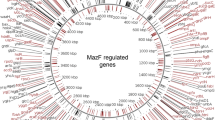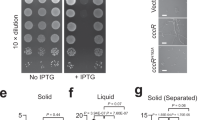Abstract
Cultivation of K99+ wild strains and transconjugants in MINCA medium with variable concentrations of glucose, glycerol, alanine, or protein-interfering antibiotics shows that the K99 antigen and its associated adhesin are expressed in different ways. The addition of cAMP to medium containing a K99-repressive concentration of glucose demonstrates that the K99-antigen production is controlled by the cAMP-CRP complex, but this does not occur with the adhesin production. Sub-inhibitory concentrations of protein-interfering antibiotics inhibit the K99-antigen production, but do not correlatively affect the adhesin production. All these experiments suggest that the K99 antigen and the adhesin are different structures whose genes are controlled by different mechanisms.
Similar content being viewed by others
Literature Cited
Curtiss, R. 1981. Gene transfer, pp. 243–256. In: Gerhardt, P. (ed.), Manual of methods for general bacteriology. Washington, DC: American Society for Microbiology.
De Graaf, F. K., Klausen-Boor, P., Van Hees, J. E. 1980. Biosynthesis of the K99 surface antigen is repressed by alanine. Infection and Immunity30:125–128.
De Graaf, F. K., Klemm, P., Gaastra, W. 1981. Purification, characterization and partial covalent structure ofEscherichia coli adhesive antigen K99. Infection and Immunity33:877–883.
Guinée, P. A. M., Veldkamp, J., Jansen, W. H. 1977. Improved MINCA medium for the detection of K99 antigen in calf enterotoxigenic strains ofEscherichia coli. Infection and Immunity15:676–678.
Guinée, P. A. M., Jansen, W. H. 1979. Detection of enterotoxigenicity and attachment factors inEscherichia coli strains of human, porcine and bovine origin: a comparative study. Zentralblatt für Bakteriologie Mikrobiologie und Hygiene243:245–257.
Isaacson, R. E. 1977. K99 surface antigen ofEscherichia coli: purification and partial characterization. Infection and Immunity15:272–279.
Isaacson, R. E. 1978. K99 surface antigen ofEscherichia coli: antigenic characterization. Infection and Immunity22:555–559.
Isaacson, R. E. 1980. Factors affecting expression of theEscherichia coli pilus K99. Infection and Immunity28:190–194.
Morris, J. A., Stevens, A. E., Sojka, W. J. 1977. Preliminary characterization of cell-free K99 antigen isolated fromEscherichia coli B41. Journal of General Microbiology99:353–357.
Morris, J. A., Stevens, A. E., Sojka, W. J. 1978. Anionic and cationic components of the K99 surface antigen fromEscherichia coli B41. Journal of General Microbiology107:173–175.
Morris, J. A., Thorns, C. J., Sojka, W. J. 1980. Evidence for two adhesive antigens on the K99 reference strainEscherichia coli B41. Journal of General Microbiology118:107–113.
Postma, P. W., Roseman, S. 1976. The bacterial phosphoenolpyruvate sugar phosphotransferase system. Biochimica et Biophysica Acta457:213–220.
Silhavy, T. J., Ferenci, T., Boos, W. 1978. Bacterial transport. B. P. Rosen, ed. New York: Marcel Dekker.
Author information
Authors and Affiliations
Rights and permissions
About this article
Cite this article
Ferreiros, C.M., Criado, MT. Different expression and genetic control for the K99 antigen and its associated adhesin. Current Microbiology 8, 221–224 (1983). https://doi.org/10.1007/BF01579550
Issue Date:
DOI: https://doi.org/10.1007/BF01579550




